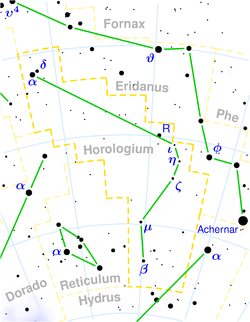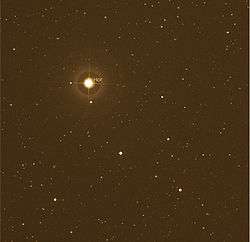Iota Horologii
Iota Horologii, Latinized from ι Horologii, is a yellow-hued star approximately 56.5 light-years away in the Horologium constellation. The star is classified as a G0Vp[2] yellow dwarf (it has previously been classified as G3 and a subgiant [IV]). It has a mass and radius larger than the Sun, and is about 50% more luminous.
| Observation data Epoch J2000.0 Equinox J2000.0 | |
|---|---|
| Constellation | Horologium |
| Right ascension | 02h 42m 33.4665s[1] |
| Declination | −50° 48′ 01.0562″[1] |
| Apparent magnitude (V) | +5.40 |
| Characteristics | |
| Spectral type | G0Vp[2] |
| B−V color index | 0.57 |
| Variable type | none |
| Astrometry | |
| Radial velocity (Rv) | 15.5 km/s |
| Proper motion (μ) | RA: 333.826±0.083[1] mas/yr Dec.: 219.488±0.086[1] mas/yr |
| Parallax (π) | 57.7143 ± 0.0537[1] mas |
| Distance | 56.51 ± 0.05 ly (17.33 ± 0.02 pc) |
| Absolute magnitude (MV) | +4.23[3] |
| Details | |
| Mass | 1.25 ± 0.01[4] M☉ |
| Radius | 1.16 ± 0.04[5] R☉ |
| Luminosity | 1.64 ± 0.05[5] L☉ |
| Temperature | 6,080[5] K |
| Metallicity [Fe/H] | 0.14–0.19[4] dex |
| Rotation | 7.70+0.18 −0.67 d[6] |
| Rotational velocity (v sin i) | 6.0±0.5[6] km/s |
| Age | 0.625[4] Gyr |
| Other designations | |
| Database references | |
| SIMBAD | data |
In 1999, a planet of the star was discovered.[8] Because the planet orbits in a near Earth orbit, Iota Horologii was ranked 69th in the list of candidates for NASA's planned Terrestrial Planet Finder mission. In 2000, a dust disc was announced around the star, but this was later determined to be an instrumental artifact.[9]
Distance and visibility
Since Iota Horologii is in the minor constellation of Horologium and is quite dim in the sky, it has not been given a traditional name. It lies roughly between the stars Eta Horologii and R Horologii (though it is not close to them in real space).

In its current position, Iota Horologii is closest to the star Chi Eridani (a yellow subgiant), approximately 7 light-years away. The closest planetary systems to Iota Horologii are HD 10647 (a yellow dwarf), approximately 57 light-years away, and Epsilon Reticuli (an orange subgiant), approximately 59 light-years away. Other star systems close to Iota Horologii include Nu Phoenicis and Zeta Reticuli.[2]
Properties
Spectrographic analysis indicates the star must have formed together with the stars of the Hyades cluster (~625 million years ago) but must have slowly drifted away, being presently more than 130 light-years away from its original birthplace. The metallicity of the star matches the abundances found in the Hyades, indicating that the metals (elements heavier than helium) in the atmosphere were not acquired because it engulfed planetary material.[4]
Measurements of magnetic activity with the 1.5 m telescope at Cerro Tololo Inter-American Observatory show that the star has a 1.6 year magnetic activity cycle which, as of 2010, is the shortest cycle measured so far for a solar like star. The sun by comparison has an 11-year magnetic activity cycle. There may be a second, longer cycle which modulates the 1.6 year cycle.[10]
Planetary system
Iota Horologii b is believed to be Jupiter-sized.[8] The planet's discovery was the result of a survey of forty stars that began in November 1992.[11]
Stability analysis reveals that the orbits of Earth-sized planets located in the planet's trojan points would be stable for long periods of time.[12]
Based on residuals in the radial velocity curve, a planet in an eccentric orbit with a period of approximately 600 days was proposed, but this was not confirmed and it seems likely that the effect was due to activity on Iota Horologii itself.[11]
| Companion (in order from star) |
Mass | Semimajor axis (AU) |
Orbital period (days) |
Eccentricity | Inclination | Radius |
|---|---|---|---|---|---|---|
| b | ≥2.48 ± 0.08 MJ | 0.96 ± 0.05 | 307.2 ± 0.3 | 0.18 ± 0.03 | — | — |
See also
References
- Brown, A. G. A.; et al. (Gaia collaboration) (August 2018). "Gaia Data Release 2: Summary of the contents and survey properties". Astronomy & Astrophysics. 616. A1. arXiv:1804.09365. Bibcode:2018A&A...616A...1G. doi:10.1051/0004-6361/201833051. Gaia DR2 record for this source at VizieR.
- "Iota Horologii". SolStation. Retrieved May 28, 2008.
- Anderson, E.; Francis, Ch. (2012), "XHIP: An extended hipparcos compilation", Astronomy Letters, 38 (5): 331, arXiv:1108.4971, Bibcode:2012AstL...38..331A, doi:10.1134/S1063773712050015.
- Vauclair, S.; et al. (2008). "The exoplanet-host star iota Horologii: an evaporated member of the primordial Hyades cluster". Astronomy and Astrophysics. 482 (2): L5–L8. arXiv:0803.2029v1. Bibcode:2008A&A...482L...5V. doi:10.1051/0004-6361:20079342.
- Bruntt, H.; et al. (2010). "Accurate fundamental parameters for 23 bright solar-type stars". Monthly Notices of the Royal Astronomical Society. 405 (3): 1907–1923. arXiv:1002.4268. Bibcode:2010MNRAS.405.1907B. doi:10.1111/j.1365-2966.2010.16575.x.
- Alvarado-Gómez, Julián D.; et al. (2018). "Far beyond the Sun – I. The beating magnetic heart in Horologium". Monthly Notices of the Royal Astronomical Society. 473 (4): 4326–4338. arXiv:1710.02438. Bibcode:2018MNRAS.473.4326A. doi:10.1093/mnras/stx2642.
- "Iota Horologii". SIMBAD. Centre de données astronomiques de Strasbourg. Retrieved August 15, 2020.
- "Extrasolar Giant Planet in Earth-like Orbit" (Press release). Garching, Germany: European Southern Observatory. July 29, 1999. Retrieved December 29, 2012.
- "Retracted in August 2001: ADONIS Discovers Dust Disk around a Star with a Planet" (Press release). Garching, Germany: European Southern Observatory. October 13, 2000. Retrieved December 30, 2012.
- Metcalfe, T. S.; et al. (2010). "Discovery of a 1.6 Year Magnetic Activity Cycle in the Exoplanet Host Star ι Horologii". The Astrophysical Journal Letters. 723 (2): L213–L217. arXiv:1009.5399. Bibcode:2010ApJ...723L.213M. doi:10.1088/2041-8205/723/2/L213.
- Kürster, M.; et al. (2000). "An extrasolar giant planet in an Earth-like orbit. Precise radial velocities of the young star iota Horologii = HR 810". Astronomy and Astrophysics. 353 (3): L33–L36. Bibcode:2000A&A...353L..33K. Archived from the original on July 25, 2011. Retrieved October 20, 2008.
- Schwarz, R.; et al. (2007). "Survey of the stability region of hypothetical habitable Trojan planets". Astronomy and Astrophysics. 474 (3): 1023–1029. Bibcode:2007A&A...474.1023S. doi:10.1051/0004-6361:20077994.
- Zechmeister, M.; et al. (2013). "The planet search programme at the ESO CES and HARPS. IV. The search for Jupiter analogues around solar-like stars". Astronomy and Astrophysics. 552. A78. arXiv:1211.7263. Bibcode:2013A&A...552A..78Z. doi:10.1051/0004-6361/201116551.
External links
- Emily Baldwin. "The Drifting Star". Retrieved April 18, 2008.
- "Extrasolar Giant Planet in Earth-like Orbit". European Southern Observatory. Archived from the original on October 13, 2008. Retrieved June 12, 2008.
- "Iota Horologii". SolStation. Retrieved June 12, 2008.
- "Notes for star HR 810". The Extrasolar Planets Encyclopedia. Retrieved June 23, 2008.
